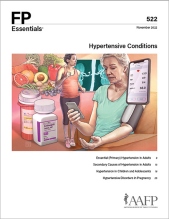
This clinical content conforms to AAFP criteria for CME.
Hypertension (HTN) in children and adolescents is a spectrum of disease, ranging from elevated blood pressure (BP) to stage 1 and 2 HTN. The prevalence of elevated BP and HTN in this age group has increased significantly over the past 20 years, particularly in girls. Screening for HTN in asymptomatic children and adolescents is controversial. Primary HTN is now the predominant cause of HTN among the pediatric population in the United States, especially among adolescents. Secondary pediatric HTN is high BP due to an underlying medical condition and is more common among children 6 years and younger. Ambulatory BP monitoring should be considered in pediatric patients with repeatedly elevated office BP measurements. All children with BP greater than the 90th percentile should be encouraged to adopt lifestyle changes, but those with persistent or severe elevations in BP may benefit from pharmacotherapy.
Case 3. PH is a healthy 11-year-old patient who is brought to your office for a well-child examination. His weight and vital signs are normal, except for the systolic blood pressure (BP), which is at the 95th percentile for age, sex, and height. PH’s mother asks you why his BP is elevated and what the next steps are to manage it.
Prevalence
Hypertension (HTN) in children and adolescents ranges from elevated blood pressure (BP) to stage 1 and 2 HTN. Primary pediatric HTN is high BP without an identifiable cause and is more common among adolescents. Primary HTN is now the predominant diagnosis of HTN among children and adolescents in the United States. Secondary pediatric HTN is high BP due to other medical conditions. Secondary pediatric HTN is estimated to be 4% of pediatric HTN cases and is more common among children 6 years and younger.53,54
Subscribe
From $350- Immediate, unlimited access to FP Essentials content
- 60 CME credits/year
- AAFP app access
- Print delivery available
Edition Access
$44- Immediate, unlimited access to this edition's content
- 5 CME credits
- AAFP app access
- Print delivery available
